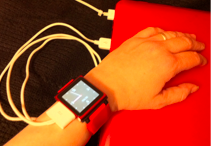 My latest toy is an iPod nano watch. It’s just a plain old iPod nano, but it slides onto a watch strap specially designed to watch-ify it. I loved it for being red and iSomething and tiny but even so I wasn’t particularly sure that it was a wise (read: financially prudent) purchase.
My latest toy is an iPod nano watch. It’s just a plain old iPod nano, but it slides onto a watch strap specially designed to watch-ify it. I loved it for being red and iSomething and tiny but even so I wasn’t particularly sure that it was a wise (read: financially prudent) purchase.
Until the moment after purchase, when I plugged it into my Macbook Pro so that I could load it up with some music and photos. There I was, standing in the Apple Store, and since I needed to keep an eye on the watch while it synced I left it attached to my wrist. I plugged the standard syncing cable into the nano, tethering myself to my Macbook, and it just felt so…true. It was like there was finally a physical manifestion of the connection between me and my computer.
That moment of delight has brought my attention to the visceral relationship I have with my many devices. I love my iPad because it’s red (thanks to my new case) and iSomething and touchscreeny but mostly I love it because it means I always have a computer with me. As much as my iPhone has served as my
 away from
away from  , it doesn’t really feel like I’m carrying a computer around. So if I actually want to show somebody something on the web, which I do about every 20 minutes (45 if I’m really trying be all analog) then I want an actual screen-sized screen with me. The iPad means that the Internet and all my Internet friends and apps and fetishes are always there with me, tucked in the big pocket of my custom-made iPad-sized purse, or (as a colleague observed today) cradled in my arms like a third baby.
, it doesn’t really feel like I’m carrying a computer around. So if I actually want to show somebody something on the web, which I do about every 20 minutes (45 if I’m really trying be all analog) then I want an actual screen-sized screen with me. The iPad means that the Internet and all my Internet friends and apps and fetishes are always there with me, tucked in the big pocket of my custom-made iPad-sized purse, or (as a colleague observed today) cradled in my arms like a third baby.
This doesn’t mean that my iPhone is superfluous: far from it. I might put my iPad in my purse or even down on a desk or table; the iPhone is always in my pocket or (if I’m pocket-less) my hand. It’s my little touchstone, especially in its silky new moshi case, and I can’t imagine I go more than ten minutes without just reaching out to make sure it’s still there, or fidgeting with it the way I imagine my great-great-great-grandfather might have worried the knots on his tallit.
Perhaps it’s time to acknowledge that our connection to technology is not simply an intellectual or emotional choice — or as some might have it, a dependence — but an actual attachment. My attachment to my iThings is not very different from my daughter’s attachment to her favourite stuffed animal or my son’s attachment to his favourite pillow. As attachment objects, these technologies provide a kind of emotional security, a sense of reassurance, a bulwark against separation anxiety.
No wonder that our most common justification for touching them so constantly is to “stay connected”: it’s not just a competitive advantage or a form of efficiency, it’s an answer to a profound emotional need. Yes, we do need to stay connected, and in our secular age we carry devices that keep us connected to our (online) community the way previous generations carried rosaries or tallit to stay connected to God. We may have more tangible proof that our attachment objects are making the connection we need — I just got an urgent email, or sorry, I’ve got to reply to this text — but ultimately they are serving the same underlying purpose. As we caress these electronic touchstones in our hands or feel their comforting weight in our pockets, we are reminded that however frightened we may feel, we are not alone.

I like this. 🙂
Enjoyed the post but I want to expand on your final thought… as a Christian my iPhone is also my tether to much of my relationship with God. It’s my Bible, bookmarked passages, devotionals, list of prayer requests, and how I connect with many fellow believers for prayer requests and encouragement.
So while I completely agree with your post I think the last paragraph is more profound that you may have realized.
Enjoyed the post but I want to expand on your final thought… as a Christian my iPhone is also my tether to much of my relationship with God. It’s my Bible,
bookmarked passages, devotionals, list of prayer requests, and how I connect with many fellow believers for prayer requests and encouragement.
So while I completely agree with your post I think the last paragraph is more profound that you may have realized.